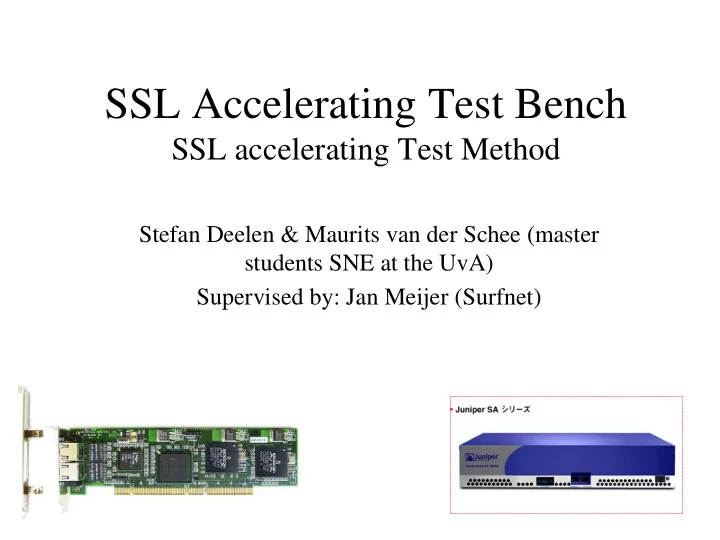

SSL Accelerating Test Bench SSL accelerating Test Method Stefan Deelen & Maurits van der Schee (master students SNE at the UvA) Supervised by: Jan Meijer (Surfnet)
Contents • Objectives • Test Method • Scope • Types of testing • Other tests • Conclusions & Future Work • Questions
Objectives Finding a test method which answers these questions: 1) What is the actual added value of an accelerator to a web server? 2) How to compare accelerator performance?
Our successful test approach: Comparative testing Performance with accelerator X vs. performance with accelerator Y Web server performance with accelerator vs. without accelerator SSL performance metric = Max. number of unique SSL handshakes per second (TPS)
Dual Xeon 3,8 Ghz server –FreeBSD 6.2-RELEASE –Apache/2.2.4 (FreeBSD) –OpenSSL 0.9.7e-p1 –Broadcom 5820 PCI crypto accelerator Three clients running linux – Ab, Httperf and autobench software – Connected through switched gigabit
SSL in-balance: How many clients?
Test Operation 1. Use Autobench to do a quick test to find the saturation point 2. “Zoom into” the saturation point for more accurate results. 3. Add or remove clients to verify you hit a server limit
Research Scope • Open source operating system • OpenSSL • SSL handshake (RSA cipher) • Apache 2.2 • Benchmark tools “Autobench and Httperf”
Types of testing • Black box – Testing focused on software’s external attributes and behavior. – From a user’s point of view. • White box – Testing with full knowledge of the algorithms, internal states, architectures, etc. – From a developers point of view.
Gray box testing • “Tests designed based on the knowledge of algorithms, internal states, architectures, or other high level descriptions of program behavior”. – Doug Hoffman • Needed because black and white box testing do not allow for balanced testing • Integral to the effective testing of Web applications
Other testing 2. OpenSSL speed benchmark • Test the performance of the crypto library used by Apache 3. Single session • Test the response time of a single request
OpenSSL speed results [root@test ~]# openssl speed rsa1024 Doing 1024 bit private rsa's for 10s: 2989 1024 bit private RSA's in 9.97s Doing 1024 bit public rsa's for 10s: 48265 1024 bit public RSA's in 9.99s timing function used: getrusage rsa 1024 bits: sign verify sign/s verify/s 0.0033s 0.0002s 299.8 4832.8
Algorithm • Accelerators may be optimized for certain algorithms and block sizes • Algorithm balance can influence preformance – RSA vs DSA balance – Rebalanced RSA • Driver may not be implemented optimal – CRT parameters used or not
OpenSSL speed conclusions • Results show the actual encrypting performance of a system. • Results may be heavily influenced by algorithm, driver and operating system • Results are easy to compare • But, you are not measuring the “added value” of the accelerator (it is white box)
Single session • Httperf results are equal to Ab (Apache bench) results • We measured a 2 ms difference between the situation with and without accelerator • The handshake takes 7 ms longer (calculated value) • We are not able to explain the difference
Httperf testing • We used a 0 byte file to focus on handshake • We used HTTP 1.0 to avoid keep-alive (and thus connection limits) • We disabled caching on the client and server side (to simulate connections from different hosts) • We measured the actual request rate (number of HTTP GET requests per second)
Autobench • …is a Perl script (OS indepent) • …automates doing series of Httperf tests • …has a client/server architecture • …enables you to do distributed tests • …produces its results in a graph
Conclusions • We developed a method that enables easy and comparable tests for SSL accelerators • Gray box testing is needed to find the actual added value of an accelerator • Choices in algorithm, operating system and drivers may multiply (!) performance • Future work may prove this method useful for a wider scope
Future work • Throughput testing • Virtual users: script that emulates site visit • Automated searching for saturation point • Other (maybe better) testing software • High performance accelerators and/or other algorithms may require an easy scalable client pool
Questions …?
Recommend
More recommend